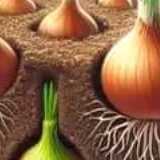1. Choose the appropriate location: Onions need fertile, well-drained soil rich in organic matter. The site should be in full sun.
2. Soil preparation: Till the soil to a depth of 15-20 cm, then add decomposed organic fertilizer to increase its fertility. The soil is preferably slightly acidic (pH between 6-7).
3. Type selection: Choose the type of onion suitable for the climatic conditions of your region. You can use seedlings, seeds, or small onions (bulbs).
4. Agriculture: If you are using bulbs: Plant the bulbs 2-3 cm deep in the soil, leaving a distance of 10-15 cm between each plant. The distance between the rows should be about 30 cm. If you are planting seeds: Sow the seeds 1-2 cm deep. Seeds can be planted in planting trays first, and then the seedlings can be transferred to the ground.
5. Irrigation: Onions need regular watering, especially in the early stages of growth. Make sure to keep the soil moist without excessive watering. Reduce watering when onions begin to form heads (skin).
6. Fertilization: Use compost or nitrogen-rich fertilizers in the initial growth stage. Reduce fertilization after onions begin to form heads.
7. Pest control: Watch out for insects such as worms and whiteflies. Natural pesticides such as neem oil can be used to control pests.
8.Harvest: Onions are ready to harvest when you notice that the leaves have begun to wilt and bend toward the ground. After harvesting, let the onions dry in the sun for 2-3 weeks before storing them
